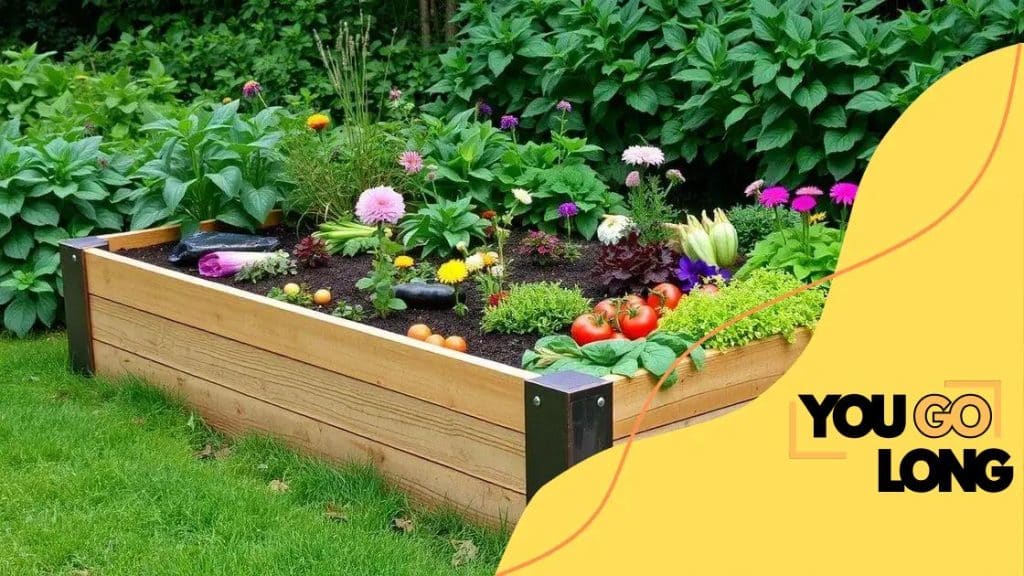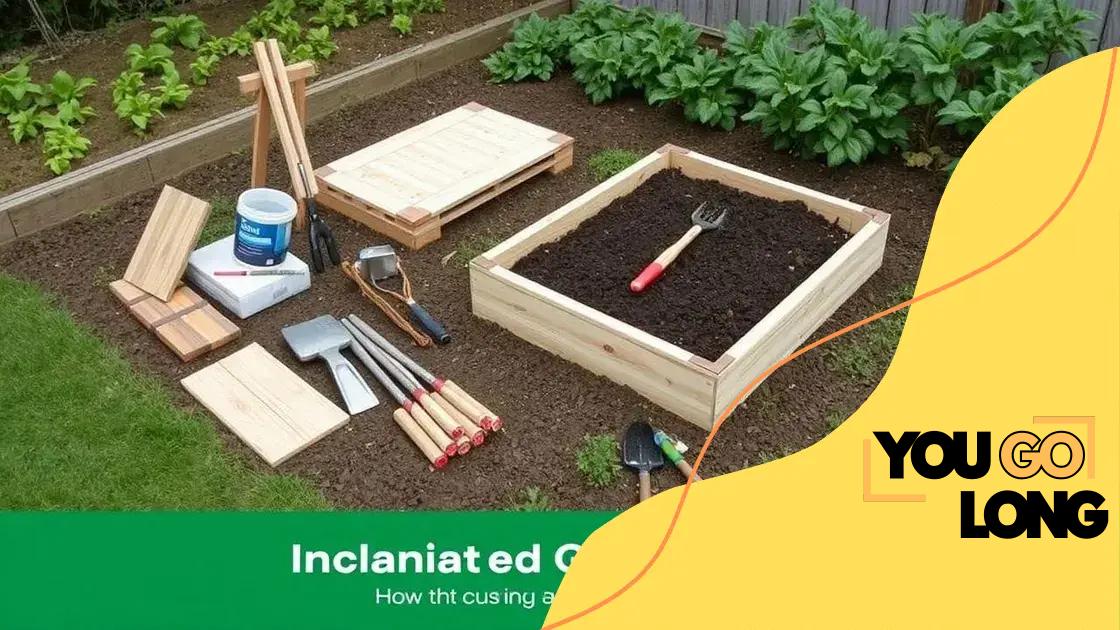How to build your own raised garden beds for success

Advertisement
To build your own raised garden beds, select durable materials like cedar, choose suitable plants, and maintain them with proper watering, mulching, and organic fertilization for optimal growth.
How to build your own raised garden beds can be easier than you think! With a bit of planning and creativity, you can create an ideal space for growing your favorite herbs and vegetables. Ready to dig in?
Understanding the benefits of raised garden beds
Understanding the benefits of raised garden beds can transform your gardening experience. By creating an elevated space for your plants, you can enjoy a variety of advantages that traditional gardening may not offer.
First, raised garden beds improve soil drainage and prevent waterlogging. This is especially beneficial for areas with heavy clay soil. The elevation also helps maintain a more consistent soil temperature, promoting healthy plant growth.
Advertisement
Advantages of Using Raised Garden Beds
Here are some key benefits:
- Easier access: Gardening becomes more comfortable, reducing strain on your back and knees.
- Better pest control: Raised beds can be designed with barriers to deter pests and keep your plants healthier.
- Extended growing season: Soil in raised beds warms up faster in spring, allowing for earlier planting.
- Soil quality control: You have complete control over the soil mix, allowing you to tailor it to your plants’ needs.
Moreover, raised beds can help minimize weeds and reduce the risk of soil compaction. By keeping the soil loose and nutrient-rich, you create an ideal environment for plant roots to thrive. They can also be visually appealing, enhancing the beauty of your garden space.
Lastly, raised garden beds are perfect for urban gardening. If you have limited space, they allow you to grow your herbs and vegetables in a small footprint. This versatility makes them a popular choice for gardeners of all experience levels.
Advertisement
Choosing the right materials for your beds
Choosing the right materials for your beds is crucial to building a successful raised garden. The materials you select can impact the health of your plants and the longevity of your garden beds.
When considering materials, think about durability and safety. For the frame of your raised garden bed, options like cedar or redwood are excellent due to their natural resistance to rot. They can last for years without needing replacement, which makes them a cost-effective choice.
Popular Materials for Raised Garden Beds
Here are some commonly used materials:
- Cedar: Naturally resistant to decay and insects, making it a top choice.
- Redwood: Similar benefits to cedar but often more expensive.
- Composite wood: Made from recycled materials and is long-lasting, though it can be pricier.
- Concrete blocks: Very durable and help retain heat, ideal for warmer climates.
Additionally, recycled plastic lumber is becoming popular as it is easy to maintain. It doesn’t rot and can withstand harsh weather. However, it may not blend in as naturally with garden surroundings.
Another aspect to consider is the soil. Ensure that the material you pick doesn’t leach harmful chemicals into the soil, affecting your plants. For example, avoid treated wood, which can contain chemicals that may seep into the soil over time.
Once you have chosen the right materials, consider how to layout your garden bed. A well-structured bed can enhance drainage and make it easier to care for your plants. Think about your garden’s design and ensure it complements the space you have available.
Steps to construct your raised garden bed

Steps to construct your raised garden bed are simple and can be completed in a weekend. Follow these straightforward guidelines to create a sturdy and functional garden space.
The first step is to choose a suitable location for your garden bed. Look for a spot that receives at least 6-8 hours of sunlight daily. Make sure the area is level and has good drainage. Once you have selected the site, you can begin measuring and marking out your bed dimensions. A common size is 4 feet by 8 feet, allowing easy access from all sides.
Gather Your Materials
Collect the necessary materials, which include:
- Wood: Cedar or redwood boards for the frame.
- Screws: Galvanized screws to prevent rust.
- Soil: A good mix of compost and garden soil.
- Tools: A drill, saw, and measuring tape.
After gathering your materials, start by cutting the wood to your desired lengths. If you’re using 4x4s for corners, cut them to 18 inches high for a deeper bed. Next, assemble the frame by laying the boards in a rectangle and using the screws to secure the corners.
Building Your Garden Bed
Once the frame is secure, lay it in the prepared spot. It’s helpful to dig down slightly to stabilize the edges. Make sure it’s leveled to avoid water pooling in one area. After positioning the frame, fill it with your soil mixture. A depth of at least 12 inches is ideal to promote healthy root growth.
As you fill the bed, mix in some compost to enrich the soil further. This will provide essential nutrients for your plants. Finally, consider adding a layer of mulch on top to help retain moisture and suppress weeds.
Finally, water the newly filled bed to settle the soil. Your raised garden bed is now ready for planting! Be sure to design a planting layout that maximizes space and promotes healthy plant growth.
Selecting the best plants for raised beds
Selecting the best plants for raised beds is essential to getting the most from your garden space. Choosing the right plants can enhance productivity and ensure a healthy harvest.
When starting your raised garden, consider the growing conditions of your area. Look for plants that thrive in your climate and soil type. For example, if you have limited sunlight, leafy greens or shade-tolerant herbs like parsley and mint can be great choices.
Popular Plants for Raised Garden Beds
Here are some excellent options to consider:
- Tomatoes: These are popular and can produce a good yield.
- Carrots: Root vegetables grow well in deep soil.
- Lettuce: Fast-growing and can be harvested multiple times.
- Radishes: Great for quick results and they’re easy to grow.
Also, consider companion planting. Certain plants grow better together and can even help deter pests. For example, planting basil alongside tomatoes can enhance their flavor and provide natural pest control.
Another significant factor is succession planting. This means you can plant quick-maturing crops, like radishes or lettuce, followed by slower-growing plants, such as tomatoes or peppers. This method maximizes your growing season and yields fresh produce throughout the year.
Lastly, make sure to check the spacing needs of each plant. Crowding can lead to poor air circulation, increasing the risk of diseases. Keeping plants spaced appropriately ensures they get adequate light and nutrients.
Maintaining your raised garden bed effectively
Maintaining your raised garden bed effectively is key to ensuring it thrives year after year. Regular care can lead to healthy plants and bountiful harvests.
One of the first tasks in maintenance is watering. Raised beds tend to drain quickly, so check the soil moisture regularly. It’s best to water deeply and infrequently, allowing the roots to grow strong and deep.
Essential Maintenance Tips
Here are some helpful tips for maintaining your raised garden bed:
- Mulching: Apply a layer of mulch to retain moisture, suppress weeds, and regulate soil temperature.
- Fertilizing: Use organic fertilizers to enrich the soil, especially at the start of the growing season.
- Weed Control: Regularly check for weeds and remove them promptly to prevent competition for nutrients.
- Pest Management: Keep an eye out for pests and use organic methods to control infestations.
Another essential aspect is soil management. Over time, soil can become compacted or depleted. To remedy this, you can add compost regularly to keep it rich in nutrients and maintain its structure. Aerating the soil with a fork can also help alleviate compaction.
Seasonal checks are crucial. In the fall, remove dead plants and debris to prevent pests and diseases from overwintering. Consider planting a cover crop to improve soil health and prevent erosion during the off-season.
By keeping up with these maintenance tasks, your raised garden bed will remain productive and vibrant, producing healthy plants for all your gardening needs.
In conclusion, building and maintaining your own raised garden beds can be a rewarding endeavor. By selecting the right materials and plants, and adhering to effective maintenance practices, you set the stage for a thriving garden. Remember to check your plants regularly, water effectively, and add organic matter to keep the soil healthy. Enjoy the fresh produce and beauty that your garden will bring to your life!
FAQ – Frequently Asked Questions about Raised Garden Beds
What materials are best for building raised garden beds?
Cedar and redwood are excellent choices due to their natural resistance to decay.
How often should I water my raised garden bed?
Water deeply but less frequently to encourage strong root growth.
What plants grow well in raised garden beds?
Fruits and vegetables like tomatoes, carrots, and herbs, such as basil, thrive in raised beds.
How can I maintain my raised garden bed effectively?
Regularly check for weeds, pests, and add organic matter like compost to enrich the soil.





